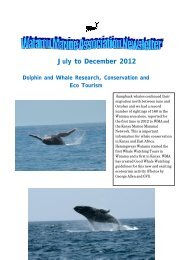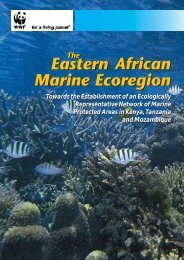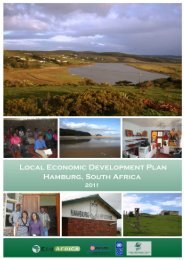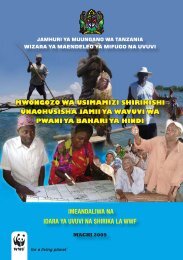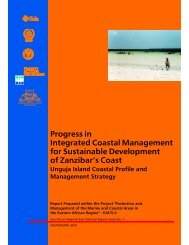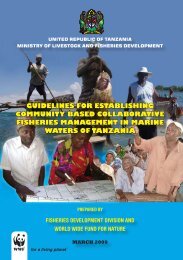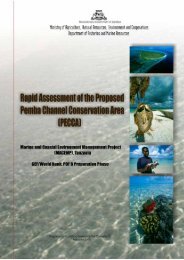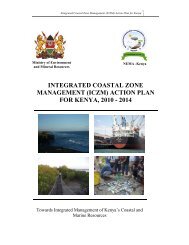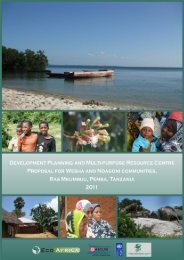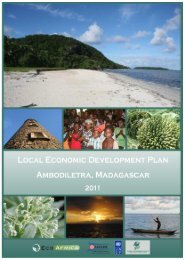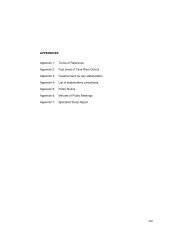Working Group 2B: What is the role of institutional frameworks and ...
Working Group 2B: What is the role of institutional frameworks and ...
Working Group 2B: What is the role of institutional frameworks and ...
- No tags were found...
You also want an ePaper? Increase the reach of your titles
YUMPU automatically turns print PDFs into web optimized ePapers that Google loves.
How do institutions such as min<strong>is</strong>triesinteract/communicate/collaborate? or do <strong>the</strong>y? <strong>What</strong> <strong>is</strong> <strong>the</strong>effectiveness <strong>of</strong> <strong>the</strong>se arrangements or institutions?• In many countries <strong>the</strong>re <strong>is</strong> inadequate collaboration <strong>and</strong> in need forimprovement.• In many countries <strong>the</strong> cabinet can act as a referee.• Where action oriented inter-min<strong>is</strong>terial committees ex<strong>is</strong>ts,collaboration can generally be improved.• Sometimes it <strong>is</strong> spontaneous collaboration amongst actors ifcommon interests are recognized.• Can be good collaboration in lower levels <strong>of</strong> government even if it <strong>is</strong>lacking at <strong>the</strong> top.• Sometimes multi sector projects can bring agencies toge<strong>the</strong>r.• Sometimes new funds (e.g. MPA trust fund) can bring agenciestoge<strong>the</strong>r.
<strong>What</strong> has <strong>the</strong> process been in redesigning or establ<strong>is</strong>hing newinstitutions to enable better collaboration? <strong>What</strong> have been <strong>the</strong>main obstacles?• The need for an overarching agency for integrated ocean management to resolveoverlaps <strong>and</strong> to accommodate emerging/new concepts.• Regular review <strong>of</strong> <strong>institutional</strong> arrangements <strong>and</strong> management measuresincluding MPAs can drive improvements in design• Recognition <strong>of</strong> <strong>the</strong> overly complex nature <strong>of</strong> process for regulating different sorts<strong>of</strong> marine activities has driven processes in <strong>the</strong> UK• Recognition <strong>of</strong> <strong>the</strong> overly complex nature <strong>of</strong> process for regulating MPAs hasdriven processes in Mozambique to create one agency or new procedures.• Obstacles:– Inter-agency/sectorial competition for ocean space.– Can make a m<strong>is</strong>take <strong>of</strong> m<strong>is</strong>placement <strong>of</strong> <strong>institutional</strong> arrangement. E.g.• Mozambique – Placement in Tour<strong>is</strong>m Min<strong>is</strong>try• Malaysia (CTI) – placement in Min<strong>is</strong>try <strong>of</strong> Science <strong>and</strong> Technology– Unwillingness to give up control over dec<strong>is</strong>ion making– Lack <strong>of</strong> lead agency <strong>and</strong> champions
<strong>What</strong> are key considerations <strong>and</strong> incentives in moving towardbetter collaboration between institutions?• Leg<strong>is</strong>lative requirements to cooperate• Realization <strong>of</strong> mutual benefits <strong>of</strong> cooperation in term <strong>of</strong> better use <strong>of</strong>resources.• Showing <strong>the</strong> benefits to f<strong>is</strong>heries managers on how MPAs can ass<strong>is</strong>t inachieving <strong>the</strong>ir goals, targets <strong>and</strong> commitments.• Showing <strong>the</strong> benefits to MPA managers <strong>of</strong> working with f<strong>is</strong>heriesmanagers e.g. outreach to f<strong>is</strong>hery community.• Showing conservation agencies that conservation objectives can beachieved through a variety <strong>of</strong> sector based tools in addition to MPAs.• Sometimes f<strong>is</strong>heries closures can be put into place more quickly thanMPAs.• Need to respect each o<strong>the</strong>rs m<strong>and</strong>ate• Scaling up to large scale eco-regions can provide more flexibility than afocus on single areas
How does reconciliation work within <strong>the</strong> framework <strong>of</strong>co‐management or a community led structure• Need a mechan<strong>is</strong>m for community to share <strong>the</strong> benefits <strong>of</strong>protection particularly when revenue <strong>is</strong> generated.• Social contracts for allocation <strong>of</strong> <strong>role</strong>s, responsibilities, <strong>and</strong>accountability <strong>and</strong> shared benefits between local communities,private sectors <strong>and</strong> governments should be encouraged• Importance <strong>of</strong> local <strong>and</strong> traditional knowledge <strong>and</strong> use <strong>of</strong> marinebiodiversity (including genetic resources) needs to beacknowledged <strong>and</strong> respected• Community led initiatives for better management <strong>of</strong> a specific areamay bring institutions toge<strong>the</strong>r• Champions within communities are also able to facilitate /influencecollaboration between groups
How does reconciliation work within <strong>the</strong> framework <strong>of</strong> <strong>the</strong> highseas?• International commitments through international agreements/treaties, UN resolutions <strong>and</strong> declarations can establ<strong>is</strong>h m<strong>and</strong>atefor reconciliation (eg. m<strong>and</strong>ate for protection <strong>of</strong> biodiversity in UNF<strong>is</strong>h Stocks Agreement <strong>and</strong> UN deep sea resolutions)• F<strong>is</strong>heries <strong>and</strong> o<strong>the</strong>r sectoral conventions can be updated to includeexplicit conservation m<strong>and</strong>ate• Joint meetings <strong>of</strong> <strong>the</strong> parties at <strong>the</strong> regional level can build trust• Developing memor<strong>and</strong>a <strong>of</strong> underst<strong>and</strong>ing can facilitatecooperation, eg. NEAFC/OSPAR experience• Development <strong>of</strong> common science platform. E.g ICES in NorthAtlantic (WIOMSA potential)• Mechan<strong>is</strong>ms for enhancing collaboration at regional levels need tobe shared <strong>and</strong> elaborated
Are MPA managers across regions sufficiently connected? Are<strong>the</strong>re social <strong>and</strong> governance networks that ass<strong>is</strong>t in improvingmanagement?• There are networks between MPA managers, but in need <strong>of</strong> support<strong>and</strong> expansion (e.g. West African, Western Indian Ocean <strong>and</strong> Bay <strong>of</strong>Bengal).• The Global Environment Facility supports an exchange <strong>of</strong> learningacross <strong>the</strong> Large Marine Ecosystem (LME) program managers(International Waters Learn Network)• LME transboundary diagnostic analys<strong>is</strong> process wherein nationalexperts have to provide information for regional analys<strong>is</strong> helps tobuild trust <strong>and</strong> collaboration at regional level• Regional f<strong>is</strong>hery body secretariats network helps to shareexperiences <strong>and</strong> best practices• Meetings within <strong>and</strong> between regional seas organ<strong>is</strong>ations help toshare experiences <strong>and</strong> best practices• Meetings <strong>of</strong> <strong>the</strong> two above should be encouraged
Can South‐South/North-South governance structures be adaptedacross cultures?• Different types <strong>of</strong> exchange programs including government,industry <strong>and</strong> community leaders need to be encouraged• The benefits <strong>of</strong> such exchange programs can be substantial but arenot yet well documented• Despite differences in cultures, can frequently find a topic <strong>of</strong>common interest <strong>and</strong> relevance• Emerging example <strong>of</strong> North-South cooperation <strong>is</strong> <strong>the</strong> partnershipbetween <strong>the</strong> OSPAR <strong>and</strong> Abidjan Conventions• Capacity development for sustainable f<strong>is</strong>heries <strong>and</strong> MPAmanagement as well as larger scale marine spatial planning <strong>and</strong>management should be a larger part <strong>of</strong> <strong>the</strong> national aid packages
<strong>What</strong> are <strong>the</strong> <strong>institutional</strong> lessons learned? at both <strong>the</strong>governmental/min<strong>is</strong>terial level <strong>and</strong> within local <strong>and</strong> communitystructures?• Progress can come from initiatives from <strong>the</strong> top, from <strong>the</strong>bottom from outside, <strong>and</strong>/or from <strong>the</strong> bottom withininstitutions• High level commitment to collaboration as well as m<strong>and</strong>atee.g. leg<strong>is</strong>lative framework, for <strong>the</strong> organ<strong>is</strong>ations tocollaborate for biodiversity conservation <strong>of</strong>ten essential toprogress• Collaboration <strong>is</strong> encouraged when agencies are required toshow evidence <strong>of</strong> <strong>the</strong>ir prior consultation with o<strong>the</strong>r agencies<strong>and</strong> stakeholders before taking an <strong>is</strong>sue or new policyproposal to cabinet for consideration• Communication on different levels needs to be built on trust
<strong>What</strong> are <strong>the</strong> <strong>institutional</strong> lessons learned? at both <strong>the</strong>governmental/min<strong>is</strong>terial level <strong>and</strong> within local <strong>and</strong> communitystructures? (cont)• Collaboration <strong>and</strong> effective communication may beencouraged through bringing regional bodies for f<strong>is</strong>heries<strong>and</strong> conservation toge<strong>the</strong>r on a regular bas<strong>is</strong>• Regional /multi-national level, consultations <strong>and</strong> collaborationneeds to include Governments, industry representatives <strong>and</strong>sectoral management agencies, scient<strong>is</strong>ts <strong>and</strong> civil society• F<strong>is</strong>hery managers may know more about local circumstances• Some stakeholders may respond better to different min<strong>is</strong>tryrepresentatives whom <strong>the</strong>y have dealt with in past, egf<strong>is</strong>heries• At <strong>the</strong> staffing levels, continuity, longevity <strong>and</strong> cons<strong>is</strong>tency <strong>of</strong>communications are key• Importance <strong>of</strong> indentifying, facilitating <strong>and</strong> involving local
Consolidated recommendations (1 <strong>of</strong> 2)• Encourage collaboration <strong>and</strong> effective communicationthrough bringing regional bodies for f<strong>is</strong>heries <strong>and</strong>conservation toge<strong>the</strong>r on a regular bas<strong>is</strong>• Promote high level commitment to collaboration as well asm<strong>and</strong>ate e.g. leg<strong>is</strong>lative framework, for organ<strong>is</strong>ations tocollaborate for biodiversity conservation• Establ<strong>is</strong>h action oriented inter-min<strong>is</strong>terial committees toimprove collaboration• Review regularly <strong>institutional</strong> arrangements <strong>and</strong>management measures including MPAs to driveimprovements in design
Consolidated recommendations (2)• Scale up MPA planning processes to national <strong>and</strong> regionallevels to enhance conservation benefits <strong>and</strong> flexibility• Make capacity development for sustainable f<strong>is</strong>heries, MPAmanagement <strong>and</strong> larger scale marine spatial planning amajor component <strong>of</strong> international ass<strong>is</strong>tance <strong>and</strong> nationaldevelopment aid packages• Use case studies to communicate mutual benefits <strong>of</strong> MPAsas well as o<strong>the</strong>r tools to relevant agencies <strong>and</strong> stakeholders• Encourage social contracts to allocate <strong>role</strong>s, responsibilities,<strong>and</strong> accountability <strong>and</strong> to clarify shared benefits betweenlocal communities, private sectors <strong>and</strong> governments



